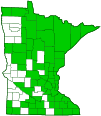Leafcurling sac spiders
(Clubiona spp.)
Overview • Description • Distribution • Taxonomy

Overview
Clubiona is a very large genus of small to medium-sized spiders known as leafcurling sac spiders. It occurs in Europe, Asia, Oceania, southern Africa, North America, Central America, and northern South America. According to the World Spider Catalog, there are 540 currently accepted Clubiona species worldwide. There are 49 species in North America north of Mexico, and at least 13 species in Minnesota.
Clubiona spiders spin silk to build a flat, tubular nest open on both ends, in which they spend the day. Some species build their nest by folding a grass leaf blade and securing it with silk. This is the feature that gives the genus its common name. Other species build their nest under bark or stones. They emerge at night to hunt on the stems and foliage of plants.
Description |
Leafcurling sac spiders range in body size from ⅛″ to ⅜″ (2.5 to 10.1 mm) long, not including their legs. The overall color is some hue of yellow or orange. Most are pale. The front part of the body (cephalothorax) is highest at the dorsal groove. The upper side (carapace) is oval when viewed from above. The dorsal groove is short, dark, and conspicuous. There are eight eyes in two rows of four. The front (anterior) row is slightly curved forward, and the eyes are usually equally spaced. The rear (posterior) row is straight or slightly curved rearward. The posterior median eyes (PME) are closer to the posterior lateral eyes (PLE) than they are to each other. The jaws (chelicerae) are dark and hairy. They are long and slender on males, short and stout on females. The forward-facing margin usually has four or five teeth, and the rear-facing margin has three or four teeth. The legs are long and fairly slender. On the front legs, the third segment (femur) has one long forward-facing bristle near the end. The abdomen is elongate oval when viewed from above. It is usually uniformly colored, and it has no chevrons. |
Distribution |
||
|
Sources |
|
| 9/4/2025 | ||
Taxonomy |
|
Class |
|
Order |
|
Suborder |
Araneomorphae (Typical Spiders) |
Infraorder |
Entelegynae |
Zoosection |
RTA clade (RTA Clade Spiders) |
Zoosubsection |
Dionycha clade spiders |
Subordinate Taxa |
|
Abbot’s sac spider (Clubiona abboti) bank sac spider (Clubiona riparia) Canada sac spider (Clubiona canadensis) conifer sac spider (Clubiona trivialis) confusing sac spider (Clubiona mixta) Johnson’s sac spider (Clubiona johnsoni) Kaston sac spider (Clubiona kastoni) Kulczynski’s sac spider (Clubiona kulczynskii) leafcurling sac spider (Clubiona rileyi) mournful sac spider (Clubiona moesta) Norway sac spider (Clubiona norvegica) spurred sac spider (Clubiona maritima) trilobed sac spider (Clubiona obesa) |
|
Synonyms |
|
Atalia Epiclubiona Euryclubiona Gauroclubiona Heteroclubiona Hirtia Hyloclubiona Japoniona |
|
Common Names |
|
sac spiders |
|
Glossary
Carapace
The hard, upper (dorsal), shell-like covering (exoskeleton) of the body or at least the thorax of many arthropods and of turtles and tortoises. On crustaceans, it covers the cephalothorax. On spiders, the top of the cephalothorax made from a series of fused sclerites.
Chelicerae
The pair of stout mouthparts, corresponding to jaws, in arachnids and other arthropods in the subphylum Chelicerata.
Femur
On insects and arachnids, the third, largest, most robust segment of the leg, coming immediately before the tibia. On humans, the thigh bone.
Visitor Photos
Share your photo of this arachnid.
This button not working for you?
Simply email us at info@MinnesotaSeasons.com.
Attach one or more photos and, if you like, a caption.
Alfredo Colon |

|
MinnesotaSeasons.com Photos
|

Slideshows
Clubiona
Lloyd-Davies

Visitor Videos
Share your video of this arachnid.
This button not working for you?
Simply email us at info@MinnesotaSeasons.com.
Attach a video, a YouTube link, or a cloud storage link.
Other Videos
Handling and observing the sac spider [Clubiona sp]
revere jack
Clubiona sp. Leafcurling Sac Spider repairs her silk cover
Maximilian Weinzierl
Clubiona sp. || Clubionidae
Mario.mzd3
Beginning of new life after molting skin Sac Spider Clubiona sp.
Herpboy Soma



